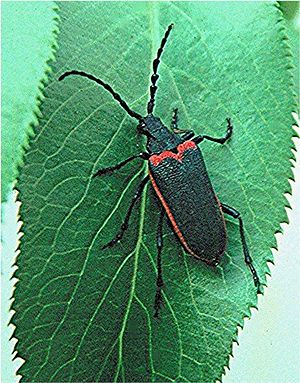Valley elderberry longhorn beetle facts for kids
Quick facts for kids Valley elderberry longhorn beetle |
|
|---|---|
 |
|
| Female valley elderberry longhorn beetle | |
| Conservation status | |
| Scientific classification |
|
| Kingdom: | Animalia |
| Phylum: | Arthropoda |
| Class: | Insecta |
| Order: | Coleoptera |
| Family: | Cerambycidae |
| Genus: | Desmocerus |
| Species: |
D. californicus
|
| Subspecies: |
D. c. dimorphus
|
| Trinomial name | |
| Desmocerus californicus dimorphus Fisher, 1921
|
|
The valley elderberry longhorn beetle (scientific name: Desmocerus californicus dimorphus) is a special type of longhorn beetle. It lives in the Central Valley of California, especially near rivers and streams. These areas are called riparian forests. This beetle is considered a federally threatened species, which means it's protected by law because its numbers are getting very low.
Contents
What Does the Valley Elderberry Longhorn Beetle Look Like?
Valley elderberry longhorn beetles have strong, thick bodies. Male beetles are about 1.25 to 2.5 centimeters (half to one inch) long. Their antennae are usually as long as their bodies.
Female beetles are a bit bigger and stronger than males. They measure about 1.9 to 2.5 centimeters (three-quarters to one inch). Their antennae are a little shorter.
Adult male beetles have bright red-orange wing covers, called elytra. These covers have four long spots. Over time, the red-orange color can fade to yellow. Adult female beetles have dark-colored wing covers.
Life Cycle of the Valley Elderberry Longhorn Beetle
Like many insects, this beetle goes through four main stages in its life:
- Egg: The female beetle lays her eggs on the bark of elderberry plants.
- Larva: The eggs hatch into larvae, which are like grubs. These larvae burrow deep into the stems of the elderberry plant. This stage can last for up to two years!
- Pupa: After the larval stage, the larva changes into a pupa. This is a resting stage where it transforms into an adult beetle.
- Adult: The adult beetles come out from March to June. They spend their time eating and finding mates. Adult beetles eat the leaves of the elderberry plant.
The elderberry plant (Sambucus species) is super important for these beetles. They are almost always found on or near these plants. For the beetles to use them as a home, the elderberry stems need to be at least 2.5 centimeters (one inch) thick at the ground.
It's often hard to tell if a beetle is living in an elderberry plant. Sometimes, the only sign is a small exit hole. The larva makes this hole just before it turns into a pupa.
Scientists have found that male valley elderberry longhorn beetles are attracted to a special chemical. This chemical is called (R)-desmolactone. It acts like a perfume to attract other beetles. Scientists might use this chemical to help keep track of the beetle population.
Where Does the Valley Elderberry Longhorn Beetle Live?
The beetle needs specific places to live, called "critical habitat." These areas are very important for its survival. Here are some of these key locations:
- Sacramento Zone: This area is in the city of Sacramento. It's bordered by the Route 160 Freeway, the Western Pacific railroad tracks, and Commerce Circle.
- American River Parkway Zone: This is a part of the American River Parkway. It's on the south bank of the American River, near River Bend Park.
- O'Connor Lakes Riparian Restoration Zone: This zone is in Sutter and Yuba Counties. It's about 10 miles south of Marysville and Yuba City, along the Feather River.
Why is the Valley Elderberry Longhorn Beetle Threatened?
Over the last 150 years, a lot of the riparian forests in California's Central Valley have been destroyed. This happened because of farming and city growth. Some experts say that nearly 90% of these forests are gone.
Even though the valley elderberry longhorn beetle can be found in many places, its numbers are going down. This is mainly because human activities have changed and broken up its river-side homes.
Here are the main reasons why this beetle is in danger:
- Loss of Habitat: Land is being used for farming or cities instead of beetle habitat.
- Bad Grazing: Animals grazing in the wrong way can harm the elderberry plants.
- River Changes: Building levees, changing river channels, removing plants, and adding rocks to shorelines destroy their homes.
- New Animals: Non-native animals, like the Argentine ant, might eat the young beetles.
- Development: New buildings, factories, and recreational areas take away their habitat.
Also, using insecticides (bug killers) and herbicides (weed killers) in farm areas and along roads might limit where the beetles can live. The age and health of elderberry plants also play a role in how many beetles can live there.
Images for kids



